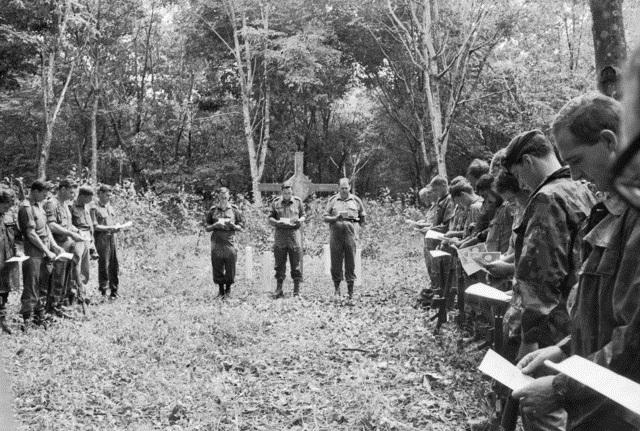The 50th anniversary of Long Tan reminds most Australians that despite winning that iconic high intensity battle, the Australians and New Zealanders lost the Vietnam War. In fact, the First Australian Task Force (1ATF) fought at least 16 big battles, and through superior firepower from artillery, armor and airpower, won them all, sometimes by a narrow margin.
But most of the struggle in Phuoc Tuy province and South Vietnam was a prolonged low intensity guerrilla war. The big battles only mattered if the US and her allies had lost them, as big battle success allowed the allies to stay in the War. Enemy defeats just forced the enemy to revert to low intensity guerrilla war, which the allies had to control if they were to win.
Long Tan was significant in that it demonstrated, for the first time in South Vietnam, how quickly 1ATF units could reconfigure themselves from low intensity war into the combined arms team needed for high intensity battle. Although denied close air support by a tropical thunderstorm, D Company of 6RAR received supporting artillery fire that at times was directed accurately to within 30 metres of the Australians. The enemy could gain no relief by ‘hugging’ their foes’, and consequently suffered very heavy casualties from artillery fire, as well as from small arms.
1ATF units were to continue to demonstrate this ability throughout the war, with close coordination with air power, armor, and artillery fire support. So 1ATF could defeat the enemy when he escalated the intensity of the war through using his main force battalions.
But the enemy’s low intensity guerrilla war saw him disbanding many of his battalions down to small units of five to 10 men, to harass allied forces and wear them down over time. The US forces failed to adapt to the enemy’s change in strategy after the Tet Offensive in 1968. The enemy no longer presented large targets that could be attacked so effectively by American firepower.
1ATF units had no difficulty in reconfiguring themselves for this type of warfare, for which they had been specifically trained. The training allowed small parties of 12 to 24 men to move silently and clandestinely through the jungle in order to see enemy parties before they saw the Australians or New Zealanders. This gave them the first burst of fire, during which most casualties were inflicted. 1ATF units established early superiority over the enemy in this contest inflicting 10 times the casualties they suffered whenever they gained the first burst of fire, which they achieved in approximately 80% of contacts.
This loss ratio meant that the enemy couldn’t stop 1ATF patrols from ranging across the Province of Phuoc Tuy. Unlike the American strategy of attrition, which defined no strategic objectives beyond killing large numbers of enemy, 1ATF strategy was to disrupt the enemy system of food supply. 1ATF sent its patrols against the enemy lines of communication, and the numerous enemy bunker systems and base camps, where most of the enemy’s large food reserves were to be found. 1ATF units captured over 1800 bunker systems and base camps. The average amount of food captured per bunker system/base camp declined each year, to almost nothing by 1970.
By mid-1969, the collapse in food supplies stopped the movement of enemy main force units into Phuoc Tuy and the local guerrilla food organizations could no longer preposition food stocks along the intended route of advance for the main force units. No other operations would penetrate to the main populated areas of Phuoc Tuy until after the units of 1ATF left Vietnam in late 1971.
The collapse in food supplies forced local guerrillas to visit the local villages every few days to collect supplies. This predictable movement allowed 1ATF to set hundreds of ambushes. Local guerrillas, including the D445 Battalion, soon found that supply parties could not be infiltrated into sympathetic villages without suffering devastating losses.
Not surprisingly, the number of enemy initiated contacts throughout Phuoc Tuy collapsed, as well as the enemy’s effective mining effort. The enemy now only had a token military presence in the Province.
But the Viet Cong probably still commanded the political loyalty of thousands of villagers in Phuoc Tuy. This was a similar situation to the last years of the Malayan Emergency (1948–1958), and Confrontation in Borneo (1963–66). In Malaya, thousands of Chinese villagers still supported the Chinese Communist Party of Malaya, while 25,000 supporters of the clandestine Communist Party existed in Borneo. But British Commonwealth forces had made the enemy militarily ineffective. That increased state of security gave the Malayan and Malaysian governments the opportunity to enact social and political reforms to undermine the political appeal of the communists.
The units of 1ATF had produced the same military result in Phuoc Tuy as in Malaya and Borneo. But this was nothing when measured against the mishandling of the war by the US Army, and the antipathy of the South Vietnamese Government towards social and political reform. The struggle for control of Phuoc Tuy remains an interesting footnote to a very large war, as does the Battle of Long Tan. Winning it allowed 1ATF to stay in the war in Phuoc Tuy and it made the enemy very cautious over 1ATF’s support fire in future battles.
But Long Tan contributed little else to the struggle that continued in Phuoc Tuy. The security success achieved by 1ATF was secured by the counter insurgency campaign it conducted relentlessly between 1966 and 1971.
